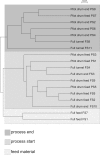Bacterial diversity at different stages of the composting process
- PMID: 20350306
- PMCID: PMC2907838
- DOI: 10.1186/1471-2180-10-94
Bacterial diversity at different stages of the composting process
Abstract
Background: Composting is an aerobic microbiological process that is facilitated by bacteria and fungi. Composting is also a method to produce fertilizer or soil conditioner. Tightened EU legislation now requires treatment of the continuously growing quantities of organic municipal waste before final disposal. However, some full-scale composting plants experience difficulties with the efficiency of biowaste degradation and with the emission of noxious odours. In this study we examine the bacterial species richness and community structure of an optimally working pilot-scale compost plant, as well as a full-scale composting plant experiencing typical problems. Bacterial species composition was determined by isolating total DNA followed by amplifying and sequencing the gene encoding the 16S ribosomal RNA.
Results: Over 1500 almost full-length 16S rRNA gene sequences were analysed and of these, over 500 were present only as singletons. Most of the sequences observed in either one or both of the composting processes studied here were similar to the bacterial species reported earlier in composts, including bacteria from the phyla Actinobacteria, Bacteroidetes, Firmicutes, Proteobacteria and Deinococcus-Thermus. In addition, a number of previously undetected bacterial phylotypes were observed. Statistical calculations estimated a total bacterial diversity of over 2000 different phylotypes in the studied composts.
Conclusions: Interestingly, locally enriched or evolved bacterial variants of familiar compost species were observed in both composts. A detailed comparison of the bacterial diversity revealed a large difference in composts at the species and strain level from the different composting plants. However, at the genus level, the difference was much smaller and illustrated a delay of the composting process in the full-scale, sub-optimally performing plants.
Figures



References
-
- Epstein E. The science of composting. Lancaster: Technomic Publishing Company; 1997.
-
- Romantschuk M, Arnold M, Kontro M, Kurola J, Vasara T. In: STREAMS final report 2005. 1. Silvennoinen A, editor. Vol. 1. Helsinki, Finland: TEKES; 2005. Älykäs kompostointi - prosessinohjaus ja hajunmuodostuksen hallinta (BIOTEHOII) pp. 224–239.
-
- Romantschuk M, Itävaara M, Hänninen K, Arnold M. In: STREAMS final report 2005. 1. Silvennoinen A, editor. Vol. 1. Helsinki, Finland: Tekes; 2005. Biojätteen kompostoinnin tehostaminen ja ympäristöhaittojen eliminointi - TEHOKOMP./Enhancement of biowaste composting and elimination of environmental nuisance; pp. 137–168.
-
- Gray KR, Sherman K, Biddlestone AJ. A Review of composting - Part 1. Process Biochem. 1971;6:32–36.
Publication types
MeSH terms
Substances
LinkOut - more resources
Full Text Sources
Molecular Biology Databases

